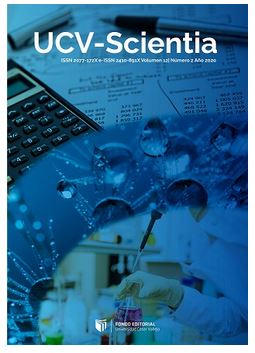Production of bioethanol from lignocellulosic waste “peladilla” Asparagus officinalis “asparagus” using Candida utilis. Var. major. C.E.C.T. 1430
DOI:
https://doi.org/10.18050/revucv-scientia.v3i2.919Keywords:
Bioetanol, Biocombustibles, Wastes lignocellulosicAbstract
The aim of this thesis was to carry out the production of bioethanol from lignocellulosic waste "peladilla" Asparagus officinalis "asparagus" using Candida utilis. var. major C.E.C.T. 1430. This proceeded to the pretreatment methods of asparagus peladilla chemists, physicists and physical chemists. Subsequently, we proceeded to the determination of total reducing sugars, determining a maximum concentration of 7 g/L which was established fermentation broth. Before starting the fermentation proceeded to construct a bioreactor of 16 cm type stirred tank with Rushton turbine and the preparation of the inoculum from the strain Candida utilis var. major CECT 1430. The culture medium was made from dilutions of total reducing sugars from 0.85 to 7.0 g / L. The process was conducted at 25 ° C, pH 4.0 - 4.5 and for a time of 72 hours, after this time was to determine the percentage of ethanol was found that the single protein and the percentage of ethanol increased progressively from 0.13 to 1.80 g / L and from 0.40 to 2.04%, respectively, as increases the concentration of "ART" of peladilla asparagus. It is concluded that ethanol production increases with increasing concentration of "ART" from peladilla. Also, the yield of C. utilis var.major is 91.66% at the optimal concentration of 1.75 g/L decrease as increasing the concentration of reducing sugars. The highest value in the production of bioethanol 2.04% equivalent to 20.4 ml of ethanol is at a concentration of 7 g/L of "ART".
Downloads
Downloads
Published
How to Cite
Issue
Section
License
Copyright (c) 2011 UCV - Scientia

This work is licensed under a Creative Commons Attribution-NonCommercial 4.0 International License.
- Share — copy and redistribute the material in any medium or format
- Adapt — remix, transform, and build upon the material.
- The licensor cannot revoke these freedoms as long as you follow the license terms.
Under the following terms:
-
Attribution — You must give appropriate credit, provide a link to the license, and indicate if changes were made. You may do so in any reasonable manner, but not in any way that suggests the licensor endorses you or your use.
- No additional restrictions — You may not apply legal terms or technological measures that legally restrict others from doing anything the license permits.













